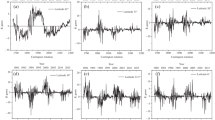Abstract
Measurements from the Mount Wilson Observatory (MWO) were used to study the long-term variations of sunspot field strengths from 1920 to 1958. Following a modified approach similar to that presented in Pevtsov et al. (Astrophys. J. Lett. 742, L36, 2011), we selected the sunspot with the strongest measured field strength for each observing week and computed monthly averages of these weekly maximum field strengths. The data show the solar cycle variation of the peak field strengths with an amplitude of about 500 – 700 gauss (G), but no statistically significant long-term trends. Next, we used the sunspot observations from the Royal Greenwich Observatory (RGO) to establish a relationship between the sunspot areas and the sunspot field strengths for cycles 15 – 19. This relationship was used to create a proxy of the peak magnetic field strength based on sunspot areas from the RGO and the USAF/NOAA network for the period from 1874 to early 2012. Over this interval, the magnetic field proxy shows a clear solar cycle variation with an amplitude of 500 – 700 G and a weaker long-term trend. From 1874 to around 1920, the mean value of magnetic field proxy increases by about 300 – 350 G, and, following a broad maximum in 1920 – 1960, it decreases by about 300 G. Using the proxy for the magnetic field strength as the reference, we scaled the MWO field measurements to the measurements of the magnetic fields in Pevtsov et al. (2011) to construct a combined data set of maximum sunspot field strengths extending from 1920 to early 2012. This combined data set shows strong solar cycle variations and no significant long-term trend (the linear fit to the data yields a slope of − 0.2±0.8 G year−1). On the other hand, the peak sunspot field strengths observed at the minimum of the solar cycle show a gradual decline over the last three minima (corresponding to cycles 21 – 23) with a mean downward trend of ≈ 15 G year−1.
Solar Origins of Space Weather and Space Climate
Guest Editors: I. González Hernández, R. Komm, and A. Pevtsov
Access this chapter
Tax calculation will be finalised at checkout
Purchases are for personal use only
Preview
Unable to display preview. Download preview PDF.
Similar content being viewed by others
References
Houtgast, J., van Sluiters, A.: 1948, Bull. Astron. Inst. Neth. 10, 325.
Livingston, W., Harvey, J.W., Malanushenko, O.V., Webster, L.: 2006, Solar Phys. 239, 41.
Livingston, W., Penn, M.J., Svalgaard, L.: 2012, Astrophys. J. Lett. 757, L8.
Mordvinov, A.V., Kuklin, G.V.: 1999, Solar Phys. 187, 223.
Pevtsov, A.A., Nagovitsyn, Y., Tlatov, A., Rybak, A.: 2011, Astrophys. J. Lett. 742, L36.
Penn, M.J., Livingston, W.: 2006, Astrophys. J. Lett. 649, L45.
Penn, M.J., Livingston, W.: 2011, In: Choudhary, D.P., Strassmeier, K.G. (eds.) The Physics of Sun and Star Spots, IAU Symp. 273, 126.
Rezaei, R., Beck, C., Schmidt, W.: 2012, Astron. Astrophys. 541, A60.
Ringnes, T.S., Jensen, E.: 1960, Astrophys. Nor. 7, 99.
Watson, F.T., Fletcher, L., Marshall, S.: 2011, Astron. Astrophys. 533, A14.
Author information
Authors and Affiliations
Corresponding author
Editor information
Editors and Affiliations
Rights and permissions
Copyright information
© 2013 Springer Science+Business Media Dordrecht
About this chapter
Cite this chapter
Pevtsov, A.A., Bertello, L., Tlatov, A.G., Kilcik, A., Nagovitsyn, Y.A., Cliver, E.W. (2013). Cyclic and Long-Term Variation of Sunspot Magnetic Fields. In: González Hernández, I., Komm, R., Pevtsov, A., Leibacher, J. (eds) Solar Origins of Space Weather and Space Climate. Springer, New York, NY. https://doi.org/10.1007/978-1-4939-1182-0_11
Download citation
DOI: https://doi.org/10.1007/978-1-4939-1182-0_11
Publisher Name: Springer, New York, NY
Print ISBN: 978-1-4939-1181-3
Online ISBN: 978-1-4939-1182-0
eBook Packages: Physics and AstronomyPhysics and Astronomy (R0)




